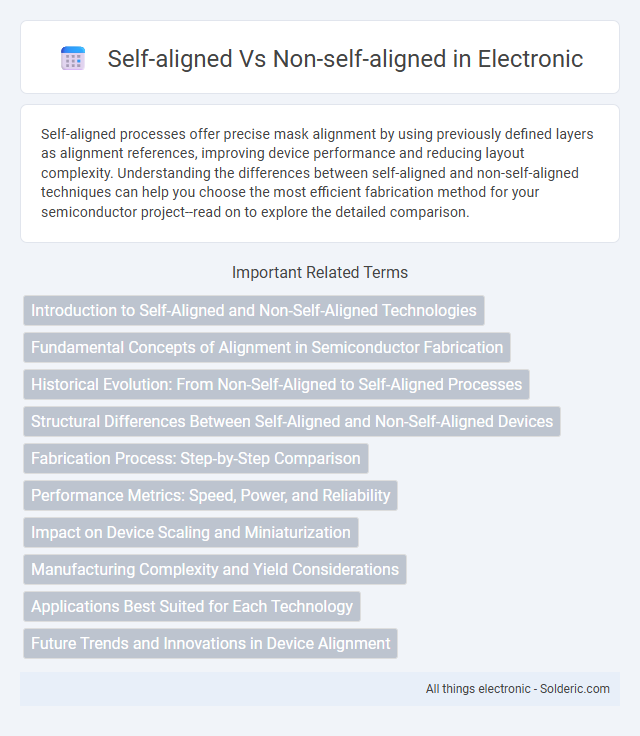Self-aligned processes offer precise mask alignment by using previously defined layers as alignment references, improving device performance and reducing layout complexity. Understanding the differences between self-aligned and non-self-aligned techniques can help you choose the most efficient fabrication method for your semiconductor project--read on to explore the detailed comparison.
Comparison Table
| Feature | Self-Aligned | Non-Self-Aligned |
|---|---|---|
| Definition | Gate electrode aligned precisely with source/drain regions. | Gate electrode and source/drain regions aligned independently. |
| Manufacturing Complexity | Higher complexity due to precise alignment techniques. | Simpler process with less stringent alignment. |
| Device Performance | Improved performance with reduced parasitic resistance and capacitance. | Higher parasitic effects, limiting speed and efficiency. |
| Scaling Capability | Better suited for advanced, scaled technology nodes. | Less effective for aggressive miniaturization. |
| Cost | Higher manufacturing cost due to advanced lithography. | Lower cost with simpler fabrication steps. |
| Applications | Used in modern MOSFETs, CMOS technology for high performance. | Found in older or less demanding device designs. |
Introduction to Self-Aligned and Non-Self-Aligned Technologies
Self-aligned technology uses a single mask to define gate and source/drain regions, improving device alignment and reducing parasitic capacitance in semiconductor manufacturing. Non-self-aligned processes rely on multiple separate lithography steps, leading to potential misalignment and higher variability in transistor performance. Your choice between these methods affects fabrication precision, yield, and overall integrated circuit efficiency.
Fundamental Concepts of Alignment in Semiconductor Fabrication
Self-aligned processes in semiconductor fabrication use existing layers as precise masks to define subsequent features, enhancing accuracy and minimizing misalignment between components like gates and source/drain regions. Non-self-aligned techniques rely on separate lithographic steps with independent masks, increasing the risk of overlay errors and reduced device performance. Understanding these fundamental alignment concepts is crucial for optimizing Your integrated circuit fabrication and ensuring device reliability and efficiency.
Historical Evolution: From Non-Self-Aligned to Self-Aligned Processes
Early semiconductor devices relied on non-self-aligned processes, where misalignments between gate and source/drain regions limited device scaling and performance. The transition to self-aligned gate technology, pioneered in the 1970s, enabled precise alignment of gate electrodes with underlying junctions, significantly reducing parasitic resistances and enhancing transistor speed. This evolution marked a critical advancement in CMOS fabrication, driving increased integration density and device reliability in modern integrated circuits.
Structural Differences Between Self-Aligned and Non-Self-Aligned Devices
Self-aligned devices integrate gate and source/drain regions with precise overlap, minimizing parasitic capacitances and improving scaling; non-self-aligned devices have separate definition processes resulting in larger overlap and increased parasitics. The self-aligned structure typically features a gate electrode that acts as a mask during source/drain implantation, ensuring accurate alignment and reduced short-channel effects. Non-self-aligned devices rely on photolithography alignment tolerances, leading to less precise junction placement and higher series resistance.
Fabrication Process: Step-by-Step Comparison
Self-aligned fabrication involves using the gate as a mask for source and drain doping, minimizing alignment errors and improving transistor performance. Non-self-aligned processes require separate lithography steps for the gate and source/drain regions, leading to increased alignment complexity and higher parasitic resistance. The self-aligned method offers enhanced precision and reduced fabrication steps, optimizing device scaling and yield.
Performance Metrics: Speed, Power, and Reliability
Self-aligned gate processes enhance device performance by reducing parasitic resistances and capacitances, resulting in higher switching speeds and lower power consumption compared to non-self-aligned structures. Self-aligned transistors exhibit improved reliability due to precise alignment, minimizing short-channel effects and variability in threshold voltage. Non-self-aligned devices often suffer from increased leakage currents and reduced drive current, leading to compromised speed and energy efficiency.
Impact on Device Scaling and Miniaturization
Self-aligned technology significantly enhances device scaling and miniaturization by precisely aligning gate electrodes with source and drain regions, reducing parasitic capacitances and enabling smaller, more efficient transistors. Non-self-aligned processes often face challenges in maintaining tight alignment, leading to increased overlap capacitances and limiting further device shrinkage. Your choice of self-aligned methods directly affects the achievable transistor density and overall performance in advanced semiconductor manufacturing.
Manufacturing Complexity and Yield Considerations
Self-aligned processes streamline manufacturing by utilizing existing structures as masks, reducing lithography steps and minimizing alignment errors, which leads to higher yield rates. Non-self-aligned processes require additional lithography and etching steps, increasing complexity and the potential for misalignment, thereby lowering overall yield. The choice between self-aligned and non-self-aligned techniques significantly impacts fabrication cost, throughput, and device performance consistency.
Applications Best Suited for Each Technology
Self-aligned technology is best suited for high-performance applications like advanced CMOS transistors in microprocessors and memory devices, where precise gate alignment reduces parasitic capacitance and enhances switching speed. Non-self-aligned technology is typically used in simpler or cost-sensitive applications such as discrete power devices and analog circuits, where manufacturing flexibility is prioritized over ultimate performance. Your choice between these technologies should depend on the need for precision and device scaling versus manufacturing cost and complexity.
Future Trends and Innovations in Device Alignment
Future trends in device alignment emphasize the shift towards self-aligned processes due to their precision and reduced variability in nanoscale fabrication. Innovations such as advanced lithography techniques and AI-driven alignment algorithms are enhancing the accuracy and scalability of self-aligned devices, outperforming traditional non-self-aligned methods. Your ability to integrate these cutting-edge technologies will be critical in optimizing device performance and manufacturing efficiency.
Self-aligned vs Non-self-aligned Infographic

 solderic.com
solderic.com